The United States is a melting pot of flavors and traditions. Immigrant communities have brought their unique tastes to our plates. From Indian curries to Mexican fajitas, our food scene is richer because of them. This article will take you on a journey through the world of ethnic foods. You’ll learn about recipes, tips, and the cultural stories behind them.
Key Takeaways : Ethnic Foods
- Ethnic foods come from cultures outside North America and Western Europe.
- Immigrants have shared their cooking traditions, ingredients, and methods with the U.S. This has made American food more diverse.
- Trading and colonization have mixed flavors and ingredients from different cultures.
- Popular ethnic foods in America include Chinese, Mexican, Italian, Japanese, Greek, French, Thai, Spanish, Indian, and Mediterranean.
- Trying ethnic foods helps us appreciate different cultures and traditions more.
Introduction to Ethnic Foods
“Ethnic food” means dishes from cultures outside North America or Western Europe. But really, all food can be seen as “ethnic” if it comes from a certain culture. Immigrants have brought their own culinary traditions, ingredients, and techniques to America. This has made American cuisine more diverse.
The Diverse Culinary Landscape of America
The U.S. is a mix of many cultures, shown in its ethnic food scene. You’ll find foods like Chinese, Mexican, Italian, and Indian. These dishes use ingredients and techniques from their immigrant roots.
“The history of American cuisine is a story of cultural exchange and the cross-pollination of flavors from around the world.”
As America grew, so did its ethnic foods. Now, we enjoy Latin flavors in tacos and Asian dishes. These culinary traditions have made American cuisine diverse and always changing.
The story of ethnic food in America is about adaptation and integration. It’s also about celebrating different culinary backgrounds.
The Melting Pot of Flavors
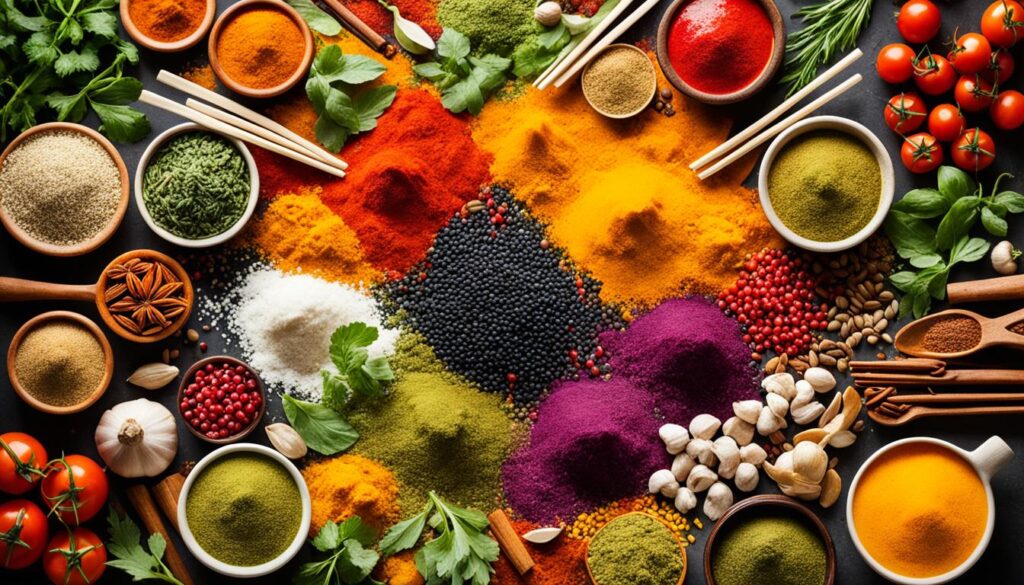
The world of food is a mix of different cultures, creating a rich and varied taste experience. New world ingredients have changed European cuisine. Asian cuisine has also left its mark on food around the world. This story shows how food is always changing and adapting.
Culinary Odyssey: The Influence of Colonization and Trade Routes
Sharing flavors and ingredients between cultures has shaped global food. Colonization and trade routes brought different lands together. This led to a mix of cultural flavors. Spices, fruits, and cooking ways were shared and became part of many countries’ foods.
| Ingredient | Origin | Influenced Cuisine |
|---|---|---|
| Tomatoes | New World | Italian, Mediterranean |
| Chili Peppers | New World | Asian, Latin American |
| Potatoes | New World | European, Asian |
| Soy Sauce | Asia | Global Cuisine |
This mix of cuisines has led to new and tasty dishes. These dishes show the world’s food heritage is rich and diverse.
Ethnic Foods in America
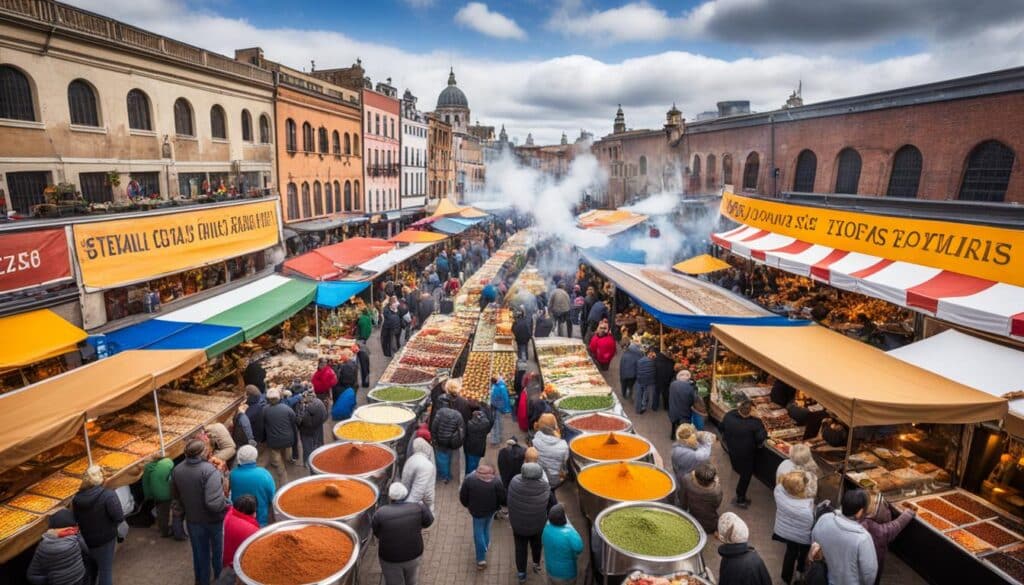
America is a mix of cultures, shown in its wide range of popular ethnic cuisines. You can find everything from Chinese dishes with their unique aromas to Mexican flavors that pop with zest. There are also Italian classics, Japanese dishes, Greek specialties, French cuisine, Thai delights, Spanish tapas, Indian curries, and Mediterranean dishes. Each offers a unique taste adventure.
These ethnic cuisines have made American food richer. Immigrants brought these foods to the US, sharing their culture and cooking skills. Now, these dishes are loved by people all over the country.
Embracing the Diversity of Ethnic Cuisines
American love for ethnic foods shows how open the country is to new cultures. People are eager to try new tastes. This has led to more ethnic restaurants, special grocery stores, and home cooking businesses. They cater to the changing tastes of Americans.
| Cuisine | Signature Dishes | Key Ingredients |
|---|---|---|
| Chinese | Kung Pao Chicken, Fried Rice, Dumplings | Soy Sauce, Ginger, Garlic, Scallions, Rice |
| Mexican | Tacos, Enchiladas, Guacamole | Chili Peppers, Lime, Cilantro, Tortillas |
| Italian | Pasta, Pizza, Tiramisu | Tomatoes, Garlic, Olive Oil, Basil |
| Japanese | Sushi, Ramen, Tempura | Rice, Seaweed, Soy Sauce, Wasabi |
| Greek | Gyros, Moussaka, Spanakopita | Feta Cheese, Olive Oil, Lemon, Herbs |
| French | Croissants, Beef Bourguignon, Crêpes | Butter, Cheese, Wine, Herbs |
| Thai | Pad Thai, Tom Yum Soup, Coconut Curry | Lemongrass, Kaffir Lime, Fish Sauce, Coconut Milk |
| Spanish | Paella, Tapas, Gazpacho | Saffron, Paprika, Olive Oil, Tomatoes |
| Indian | Curry, Naan, Biryani | Cumin, Coriander, Turmeric, Basmati Rice |
| Mediterranean | Hummus, Falafel, Kebabs | Chickpeas, Tahini, Olive Oil, Herbs |
The American food scene is always changing, and ethnic cuisines are leading the way. They offer a world of flavors for those who love to explore new tastes.
Culinary Continents
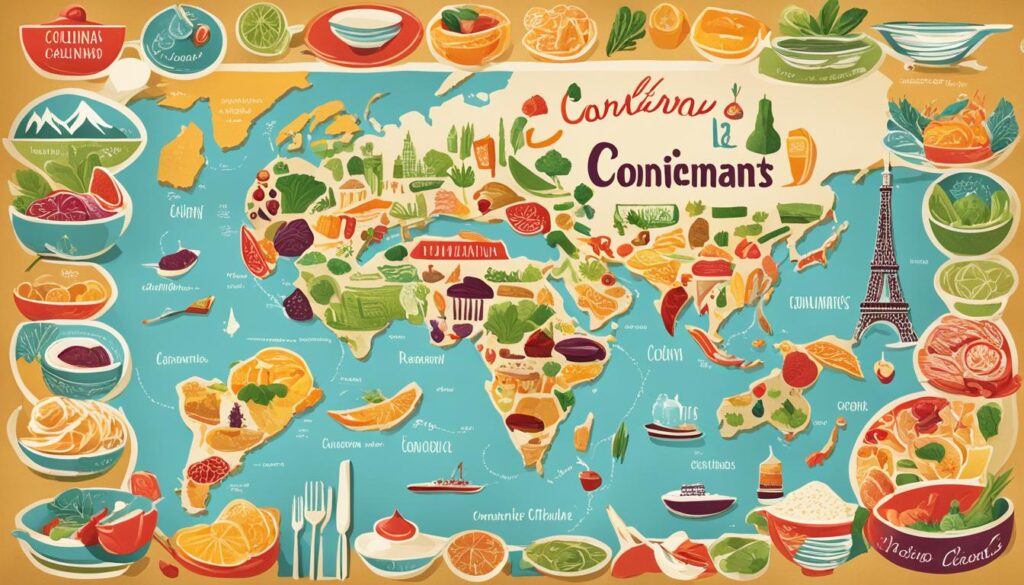
The world of ethnic foods is full of diverse flavors and traditions. We can group these into “culinary continents” based on what they share. These include Asian, Latin, Mediterranean, and Indian cuisines, each with its own flavors and ingredients.
Asian Cuisine: A Fusion of Flavors
Asian cuisine covers many traditions, from India’s aromatic curries to Japan’s delicate sushi. They use umami-rich ingredients like soy sauce and fermented pastes for depth of flavor. These dishes balance sweet, sour, and spicy tastes for a unique experience.
Latin American Flavors: A Vibrant Tapestry
Latin America’s diverse cultures add a lively touch to global cuisine. Their food is known for chili peppers, tropical fruits, and staples like corn and beans. From Mexico’s smoky dishes to Peru’s citrusy flavors, Latin American cuisine is full of variety.
Mediterranean Cuisine: A Celebration of Simplicity
The Mediterranean is famous for its healthy, tasty foods. It focuses on fresh ingredients and uses olive oil, herbs, and spices for flavor. From Italy’s hearty dishes to Greece’s zesty flavors, it celebrates simplicity and quality.
Indian Cuisine: A Kaleidoscope of Spices
Indian cuisine is a powerhouse of flavors, with many regional specialties. It’s known for its spices like cumin and turmeric, creating a mix of sweet, sour, and spicy tastes. From the north’s fragrant biryanis to the south’s tangy curries, Indian food is a feast for the senses.
Exploring these “culinary continents” helps us appreciate the diversity of ethnic foods and their cultural roots. Whether you love food or are just curious, diving into ethnic cuisine is a journey of discovery and global culinary exploration.
Ethnic Foods Pantry Essentials
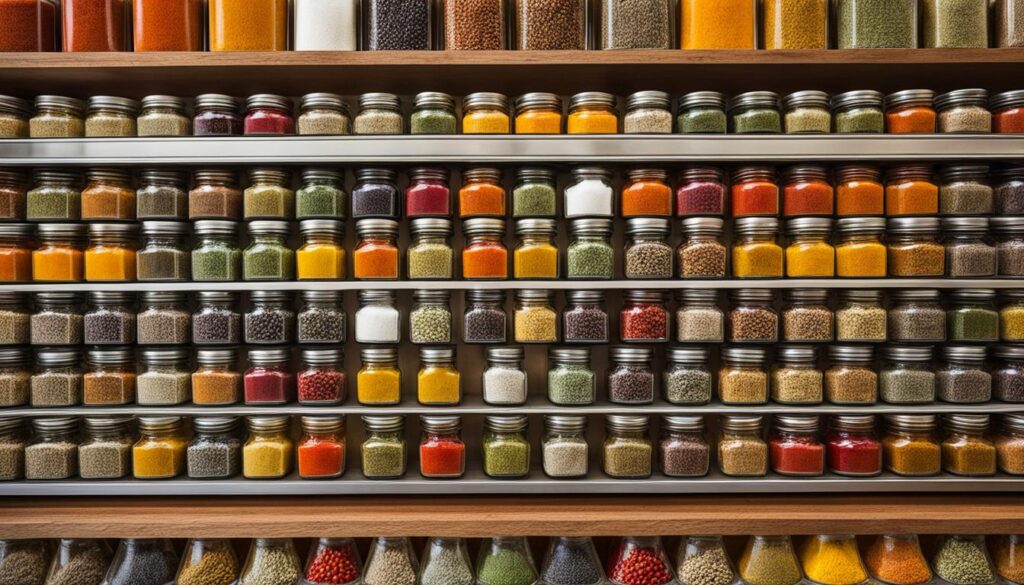
To make tasty Asian, Latin, Mediterranean, and Indian dishes at home, you need the right ethnic foods pantry. These essential ingredients and seasonings let you explore international flavors. They’ll take your cooking to new levels.
Key Ingredients for Asian Cuisine
- Soy sauce
- Rice vinegar
- Sesame oil
- Garlic and ginger
- Hoisin sauce
- Mirin (Japanese rice wine)
- Fish sauce
- Chili oils and pastes
Essentials for Latin-Inspired Dishes
- Tomatoes and tomato paste
- Cumin, chili powder, and paprika
- Cilantro and lime
- Beans (black, pinto, kidney)
- Corn tortillas and taco shells
- Avocado and queso fresco
Mediterranean Pantry Staples
- Olive oil
- Garlic and onions
- Oregano, basil, and parsley
- Olives and feta cheese
- Chickpeas and lentils
- Lemons and za’atar seasoning
Indian Cuisine Essentials
- Garam masala and cumin
- Turmeric and coriander
- Chili peppers and ginger
- Coconut milk and yogurt
- Basmati rice and naan bread
- Tamarind and mustard seeds
With these essential ingredients and seasonings, you’re set to make real and tasty Asian, Latin, Mediterranean, and Indian-inspired dishes at home. Enjoy your home cooking adventures.
Ethnic Foods Trends
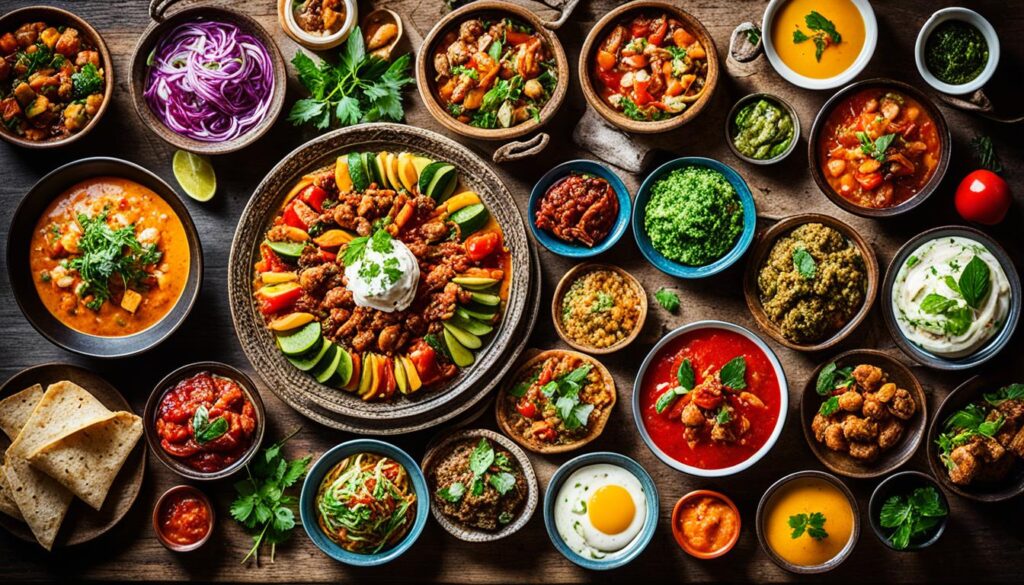
The world of ethnic foods is seeing new trends that are exciting. Southeast Asian and Peruvian cuisines are leading the way. They bring vibrant flavors and bold tastes to the table.
Embracing the Flavors of Southeast Asia
Southeast Asian food has won over many with its mix of sweet, sour, salty, and spicy flavors. Foods like Thai curries, Vietnamese pho, and Indonesian rendang are now popular. They take diners on a trip to the lively streets of Bangkok, Hanoi, and Bali.
The Rise of Peruvian Cuisine
Peruvian food is becoming a big hit, thanks to its mix of Andean, Spanish, Japanese, and Chinese flavors. Ceviche, lomo saltado, and quinoa dishes are now common on menus. People love to try the unique tastes of this South American cuisine.
Embracing Regional Ethnic Cuisines
There’s a move towards exploring regional and authentic ethnic foods too. People are looking for the real tastes of places like rural Italy and Northern India. They want to dive deep into the food traditions of different cultures.
Authentic Ethnic Cuisine and Ethnic Fusion
There’s also a trend towards mixing different ethnic flavors and cooking styles. Chefs and cooks are blending tastes from various cultures. This creates new and exciting dishes that surprise and delight.
These trends show how rich and diverse the world’s food heritage is. As people keep trying new flavors, the future of ethnic food looks bright and full of discovery.
Ethnic Foods: Recipes And Tips
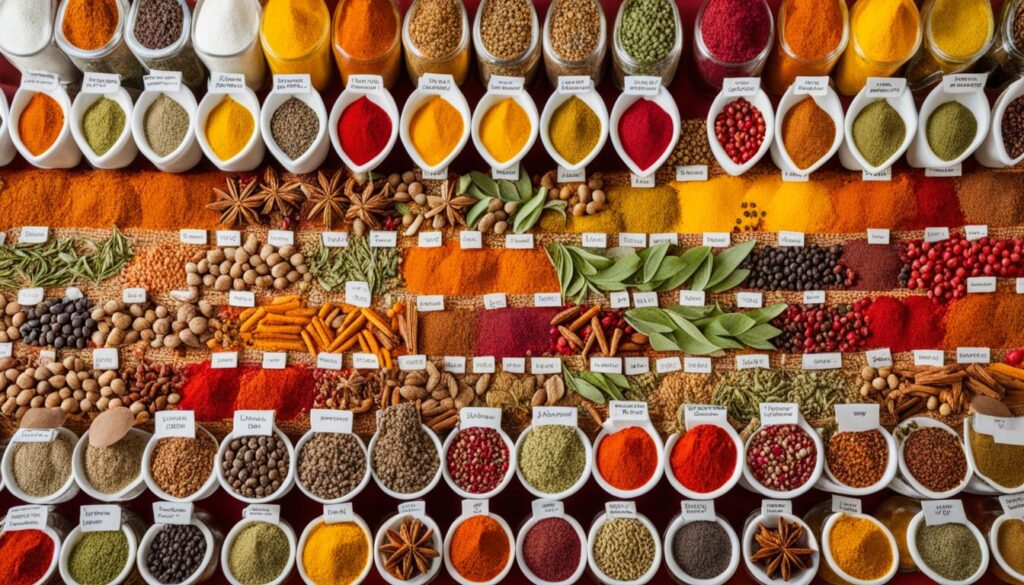
Exploring ethnic cuisines is a fun culinary adventure. It’s great for both seasoned cooks and beginners. It opens up new flavors and experiences. We’ll share some delicious recipes and tips to bring global flavors to your kitchen.
Ethnic Food Recipes to Try at Home
Start your global cooking journey with these tasty recipes:
- Authentic Pad Thai: Enjoy the sweet, sour, and savory mix in this popular Thai dish.
- Homemade Chicken Tikka Masala: Dive into the rich, creamy taste of this famous Indian curry.
- Zesty Beef Tacos with Homemade Salsa: Experience Mexico’s vibrant flavors with this simple recipe.
- Fragrant Pho: Enjoy this aromatic Vietnamese noodle soup full of complex flavors.
Ethnic Cooking Tips for the Home Chef
Improve your ethnic dishes with these tips:
- Embrace Authentic Ingredients: Use traditional spices, herbs, and produce for true flavor.
- Master Flavor Balancing: Mix sweet, sour, salty, and spicy for the right taste.
- Incorporate Textural Contrast: Add crunchy, creamy, and chewy for a fun dining experience.
- Explore Cooking Techniques: Learn stir-frying, braising, and steaming to enhance your dishes.
With ethnic recipes and cooking skills, you can take your taste buds on a world tour. Start cooking and enjoy the flavors from around the globe in your kitchen.
Ethnic Foods Fusion
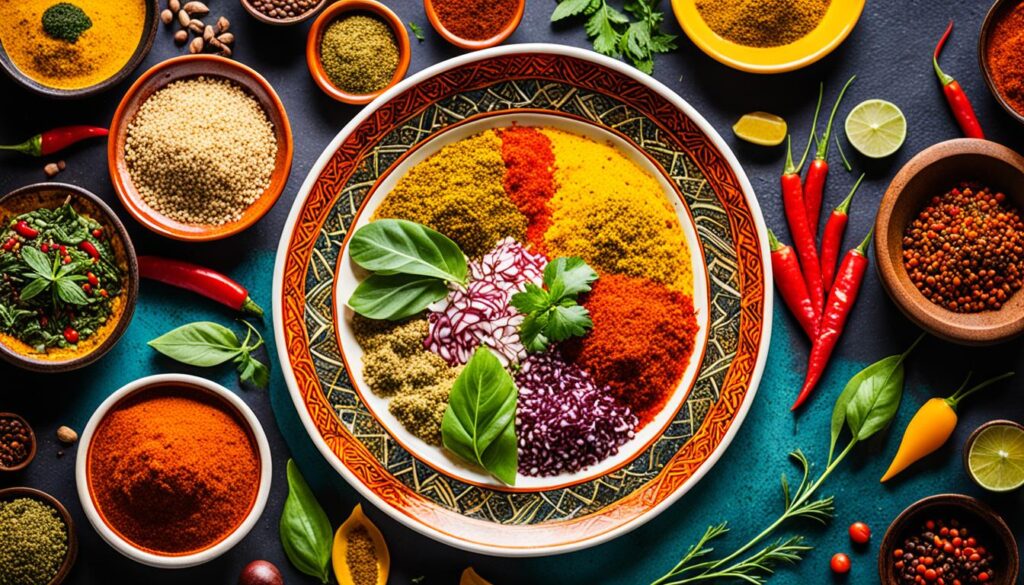
A creative change is happening in the world of ethnic cuisine. Chefs and home cooks are mixing flavors from different cultures. They’re making innovative dishes that go beyond traditional ethnic food. These dishes are exciting food lovers all over the world.
The idea of mixing global flavors is not new. But now, it’s more popular than ever. It’s changing how we see ethnic foods. These blended cuisines bring together the rich flavors of different cultures.
Exploring the Fusion Frontier
Chefs and cooks are mixing Mexican and Asian flavors, or Mediterranean and Indian spices. The options for ethnic food fusion are endless and thrilling. They’re trying new flavor mixes, making dishes that surprise us and take us on new food adventures.
Imagine a Thai-inspired taco, a sushi roll with a Latin twist, or pasta with Middle Eastern flavors. These innovative dishes show how mixing different cuisines leads to amazing creativity.
“The art of ethnic food fusion lies in respecting the integrity of each cuisine while seamlessly blending them to create something truly unique and delectable.”
By trying these blended cuisines, we’re not just tasting new foods. We’re also learning to appreciate the diversity of global food cultures.
Celebrating Diversity Through Food
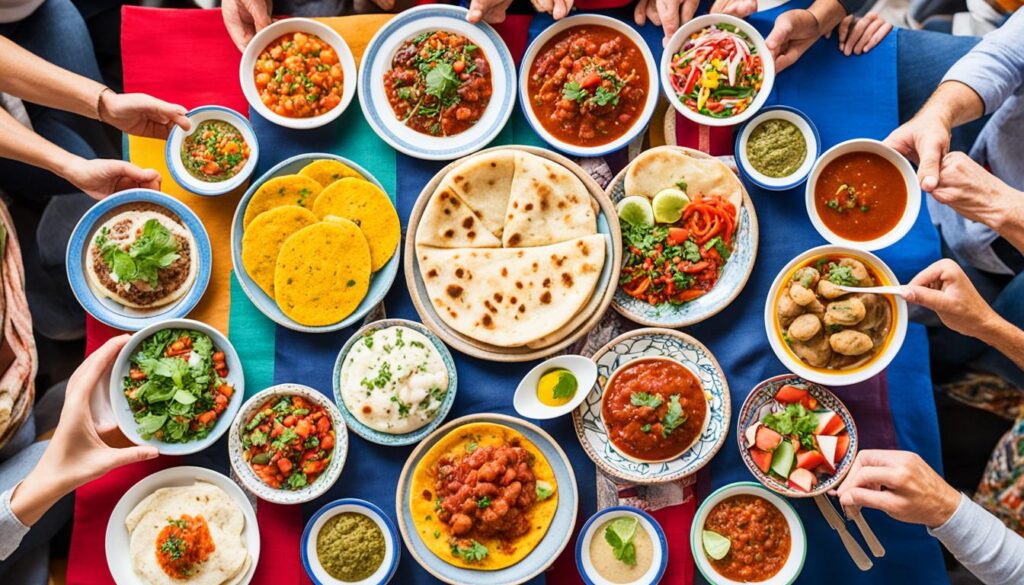
Exploring ethnic foods takes us on a journey to understand and celebrate the world’s cultures. We discover flavors, aromas, and techniques that show the rich heritage of different people. This journey lets us connect with the stories and traditions of others.
Trying ethnic foods helps us appreciate the unique cultures of our world. Each dish tells us about the history, customs, and celebrations of its region. It’s a way to connect with the past and understand our shared human experience.
Cultivating Cultural Appreciation
Engaging with ethnic foods makes us step out of our comfort zones. We learn about new spices and ingredients. This helps us see things from different perspectives, building empathy and respect.
Celebrating different culinary traditions nourishes our bodies and souls. It connects us to the stories and experiences of communities around the world. This helps us appreciate the diversity that makes our world rich.
“Sharing a meal is the most intimate way to connect with someone from a different culture. It’s an invitation to step into their world and experience their traditions firsthand.”
When we enjoy the flavors of the world, we learn to appreciate different cultures. Exploring ethnic foods helps us respect and understand the diversity of human civilization. It brings us closer to a more inclusive and harmonious global community.
Ethnic Foods Around the World
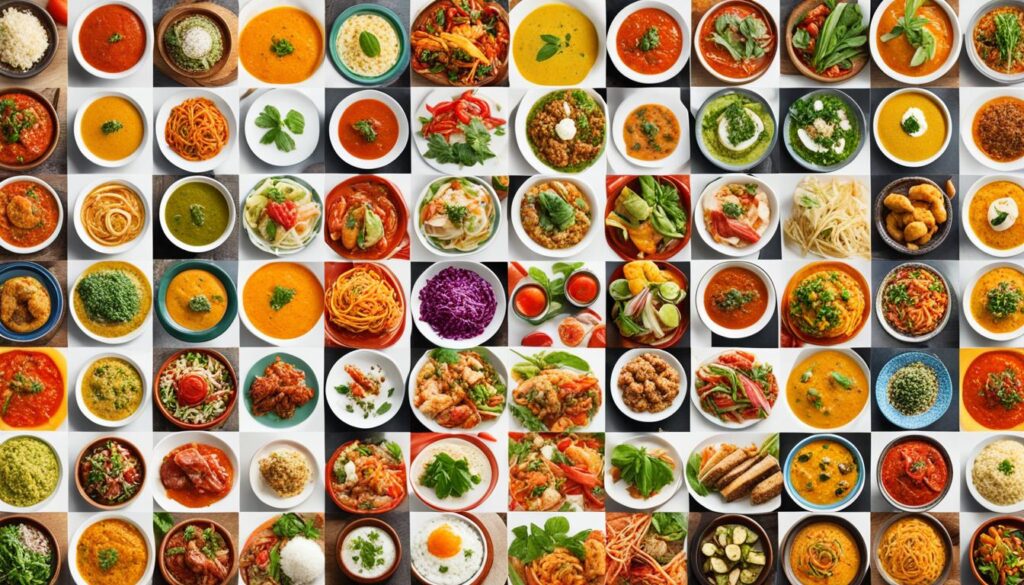
The world is full of diverse cultures, each with its own special foods. Let’s go on a journey to explore the rich and tasty ethnic dishes from around the globe. We’ll taste the vibrant flavors of China and Japan, and the aromatic spices of Thailand, Cambodia, and Indonesia. These dishes are a feast for the senses.
Discover the Wonders of Asian Cuisine
In China, you’ll find a mix of flavors in its many regional dishes. Enjoy the rich Peking duck or the spicy Mapo tofu. Nearby, Japan offers simple yet elegant dishes like sushi and ramen.
Traveling south, the scents of Thailand will amaze you. You’ll find dishes like lemongrass and kaffir lime-infused meals. Cambodia has its own unique tastes, like the coconut-based Amok Trey and the stir-fried beef Lok Lak.
In Indonesia, a world of flavors awaits. From the spicy rendang of Sumatra to the tasty nasi goreng, there’s much to explore.
Explore the Vibrant Flavors of the Indian Subcontinent
India is known for its diverse and rich food. You’ll find everything from tandoor-baked naan to creamy butter chicken. The South offers coconut-infused curries and dosai that are just as exciting.
Heading west, Iran offers a unique taste experience. Try the saffron rice dishes like Chelo Kebab, or the fragrant pomegranate and pistachio flavors.
Trying these dishes from around the world reminds us that food connects us. It helps us understand and celebrate our diverse world.
Also Read : How to Make Vegan Buffalo Wings?
Conclusion
Exploring ethnic foods has shown us how diverse culinary traditions can broaden our tastes and connect us with different cultures. We’ve seen how flavors from around the world mix and shape American cuisine. This journey has been both eye-opening and tasty.
From the spices of Indian curries to the rich sauces of Japanese dishes, and the zesty tastes of Latin American food, ethnic foods offer endless culinary adventures. By using the right ingredients and seasonings, we can make these flavors at home.
It’s key to celebrate the diversity that ethnic foods add to our meals and our lives. By enjoying the unique tastes and traditions of various cultures, we grow closer to the global community we’re part of. Let’s keep exploring, trying new things, and enjoying the world of ethnic foods, one delicious bite at a time stir-fry.
FAQs
Q: What are some favorite ethnic foods?
A: Some favorite ethnic foods include Thai curry, Colombian arepas, Ethiopian injera, and Chinese dumplings.
Q: What does it mean when we hear the term “ethnic food”?
A: When we hear the term “ethnic food,” it typically refers to traditional foods that come from a specific country or culture other than one’s own.
Q: What are some tips for cooking the best ethnic foods?
A: Tips for cooking the best ethnic foods include using authentic ingredients, mastering traditional techniques such as stir-frying or grilling, and trying out new spice blends for added flavor.
Q: How can I add more flavor to my dishes inspired by foods from other countries?
A: You can add more flavor to your dishes inspired by foods from other countries by incorporating ingredients like peanuts, green chilies, sesame seeds, ginger, garlic, or mint.
Q: What are some popular dishes from different ethnicities?
A: Popular dishes from various ethnicities include Italian pasta dishes, Mexican tacos, Chinese stir-fries, and Ethiopian lamb stews.
Q: How can I make my meals more exotic and flavorful?
A: You can make your meals more exotic and flavorful by experimenting with ingredients like mango, papaya, coconut milk, curry powder, scotch bonnet peppers, or Caribbean spices.
Q: What is the country of origin known for its diverse and delicious traditional foods?
A: Thailand is known for its diverse and delicious traditional foods, such as Pad Thai, Tom Yum soup, and green curry.
Source Links
- https://www.tenderfilet.com/articles/cooking-class/ethnic-food-world-cuisine-made-simple/
- https://www.tasteofhome.com/collection/travel-around-the-world-in-80-meals/
- https://ethnojunkie.com/?page_id=989


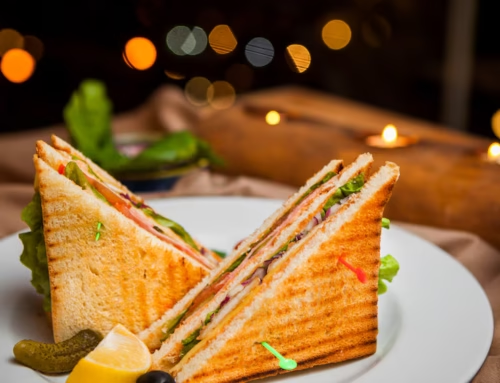

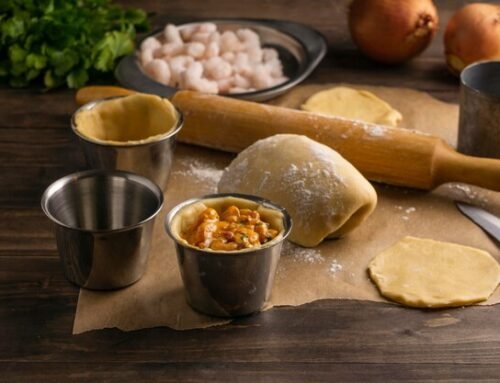



Leave A Comment